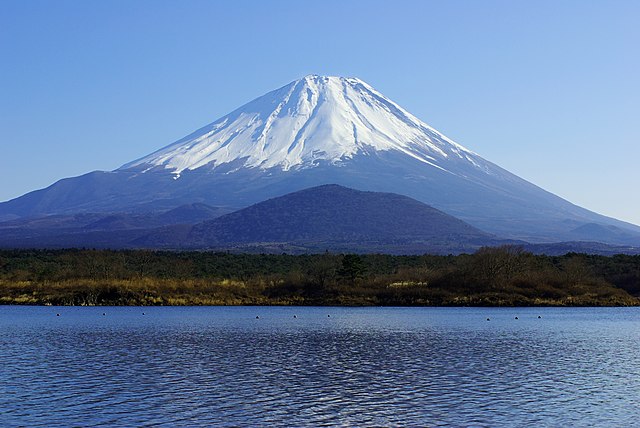Mount Fuji
volcano in Yamanashi and Shizuoka Prefectures, Japan From Wikipedia, the free encyclopedia
Mount Fuji (富士山, Fuji-san) is the tallest mountain in Japan, at 3,776 metres (12,388 ft) high.[1] It is also a volcano. It is on the border between Shizuoka Prefecture and Yamanashi Prefecture. Mount Fuji is a famous cultural icon of Japan, as a lot of people have painted it and taken photographs of it. It became the 13th UNESCO World Heritage Site in Japan on June 22, 2013. The last time it erupted was from 1707 to 1708.

Dormant volcano
Mount Fuji is officially classified as an active volcano,[2] but some describe Fuji as dormant or inactive.[3]
The last major event was the Hōei eruption of Mount Fuji which started on December 16, 1707 (Hōei 4, 23rd day of the 11th month) and ended about January 1, 1708 (Hōei 4, 9th day of the 12th month) during the Edo period.[4] Cinders and ash from Fuji fell like rain in Izu Province, Kai Province, Sagami Province, and Musashi Province.[5]
Shinto
The mountain is thought to be named after Fuchi, the Buddhist fire goddess.[6] The mountain is sacred in the Shinto religion and at the bottom of the mountain are shrines to the goddess Konohananosakuya-hime (コノハナノサクヤヒメ)).[6]
Climbing
Many people climb Mt. Fuji every year. The official climbing season is in the summer: July 25 to August 25.[6] There are three mountain-climbing routes on the Shizuoka side of Mt. Fuji. There is a post office on the top of Mt. Fuji which is open only in summer. The post office was built in 1909 and is the highest post office in Japan.[7]
Mountain in art
In 2009, Mount Fuji was recognized as one of the 100 Landscapes of Japan which best show contemporary Japan and its culture in the Heisei period.[8]
Related pages
References
Other websites
Wikiwand - on
Seamless Wikipedia browsing. On steroids.






